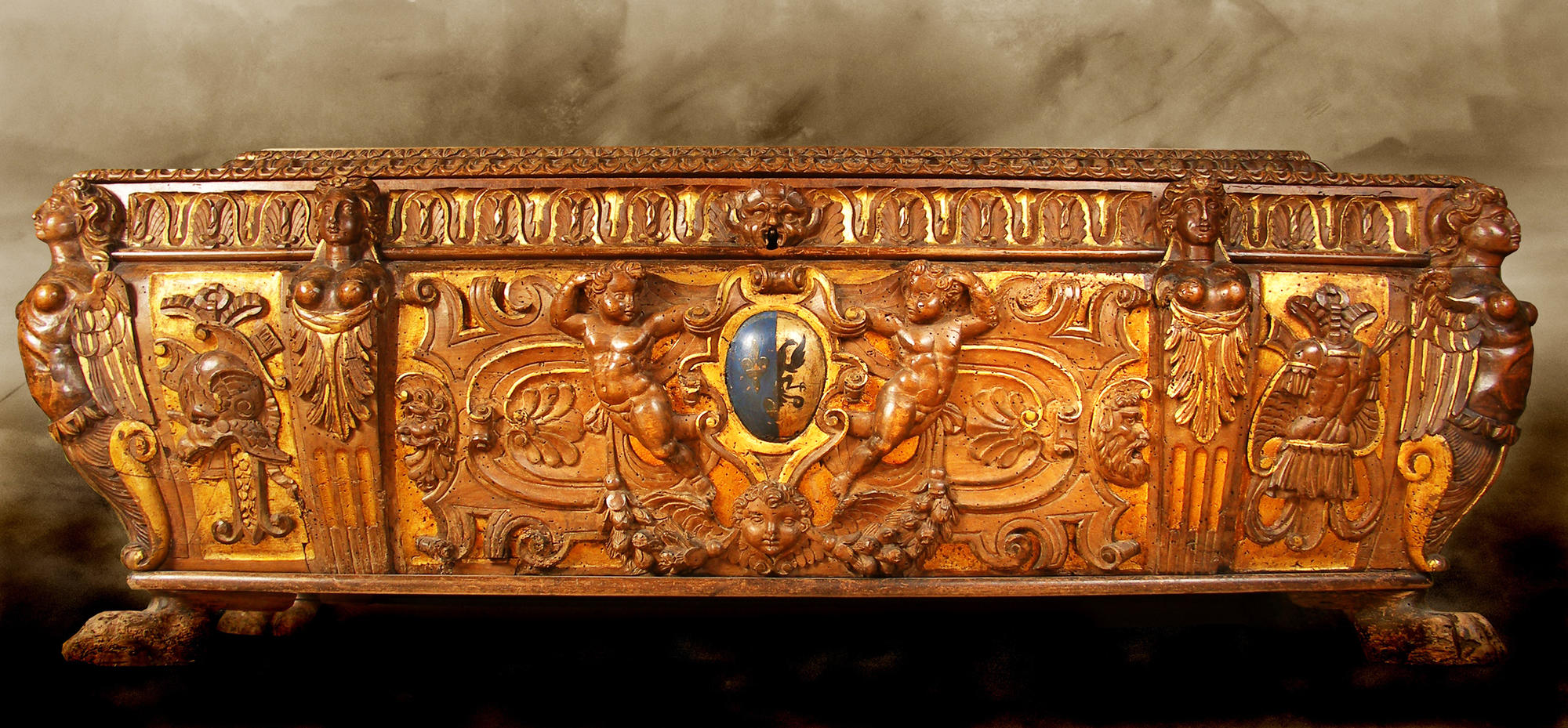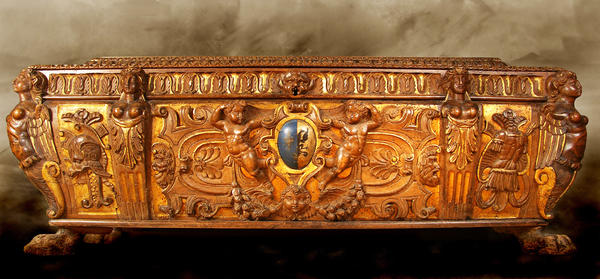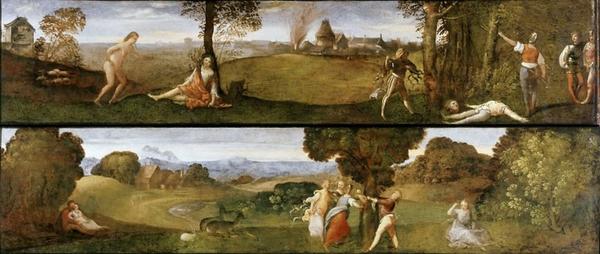This wedding chest was created by an unknown master at the end of the 16th century in Florence. It was made from walnut and decorated with carving and gilding. The chest served as the dowry of a rich bride, therefore, in the centre of the item, the artist combined the coats of arms of two families into one coat of arms. Against the gold background stands out vividly a half of a double-headed eagle, against the blue — a golden lily. The family sign is supported by two little boys with wings — putti. They were often portrayed during the Renaissance; they resembled at the same time both ancient Greek Eros and Christian angels. On the sides of the chest, the author carved military attributes and female semi-nude figures.This wedding chest was created by an unknown master at the end of the 16th century in Florence. It was made from walnut and decorated with carving and gilding. The chest served as the dowry of a rich bride, therefore, in the centre of the item, the artist combined the coats of arms of two families into one coat of arms. Against the gold background stands out vividly a half of a double-headed eagle, against the blue — a golden lily. The family sign is supported by two little boys with wings — putti. They were often portrayed during the Renaissance; they resembled at the same time both ancient Greek Eros and Christian angels. On the sides of the chest, the author carved military attributes and female semi-nude figures.
Chest – cassone
Время создания
late 16th century
Размер
62.0х165.7х58.5 cm
Техника
Wood (walnut), carving, gilding
Коллекция
Выставка
3
Открыть в приложении#3
Unknown author
Chest – cassone
#2
#4
Back in medieval Europe, chests became an indispensable piece of furniture: in them they stored and transported property, on them they sat and slept. Until the 13th century, they were chiselled out of solid wood, and then they became to be made of planks. Gradually, the purpose of chests changed: simple forms began to be decorated with sculptural decor, and the piece of furniture turned into a luxury item. By the Renaissance, the wedding cassone chest, ‘cassone’ in Italian, had become one of the most expensive items in the house.
At first, they the decorated cassone with artificial marble or upholstered it with expensive fabrics. Then masters began to paint them and carve relief compositions on them. For subjects, artists often turned to history, religion and ancient mythology. It is known that chests were also painted by famous painters: Sandro Botticelli, Filippino Lippi, Titian.
At first, they the decorated cassone with artificial marble or upholstered it with expensive fabrics. Then masters began to paint them and carve relief compositions on them. For subjects, artists often turned to history, religion and ancient mythology. It is known that chests were also painted by famous painters: Sandro Botticelli, Filippino Lippi, Titian.
#6
Titian. Cassone panel The Polydorus (Son of Priam) and the Birth of Adonis’, 1505-1510
#7
The cassone from the Yaroslavl Museum of Fine Arts was made after the sketch of Bernardo Buontalenti, Giorgio Vasari’s student. The artist’s drawing is kept in the Uffizi Gallery. It depicts half of the chest: the painted chest stands on a lion’s paws and is decorated with female figures on the sides. There are five such items in Russia: three wedding chests after Buontalenti’s sketches found home in the Hermitage, two – in the Yaroslavl Museum of Fine Arts.
This chest used to belong to Vasily Kochubey, Active State Councillor, Master of Ceremonies of the court of Nicholas II. At first, the item adorned the Count’s mansion in Tsarskoye Selo. In 1917, even before the revolution, the chest was taken to Yaroslavl along with part of the Kochubey collection. After the October events, the property was nationalised and transferred to the museum collection.
This chest used to belong to Vasily Kochubey, Active State Councillor, Master of Ceremonies of the court of Nicholas II. At first, the item adorned the Count’s mansion in Tsarskoye Selo. In 1917, even before the revolution, the chest was taken to Yaroslavl along with part of the Kochubey collection. After the October events, the property was nationalised and transferred to the museum collection.
#8
Yaroslavl Museum of Fine Arts
читать дальшескрыть
00:00
00:00
1x
Chest – cassone
Время создания
late 16th century
Размер
62.0х165.7х58.5 cm
Техника
Wood (walnut), carving, gilding
Коллекция
Выставка
3
Открыть в приложении
Поделиться




